
Ch 5 - Electronic and Mobile Commerce and Enterprise Systems
Electronic Commerce: conducting business activities electronically over computer networks
Types of E-Commerce:
Business-to-business (B2B): all participants are organisations. It is a useful tool for connecting business partners in a virtual supply chain to cut resupply times and reduce costs
Business-to-Consumer (B2C): where customers deal directly with an organisation and avoid intermediaries
Consumer-to-Consumer (C2C): Involves consumers selling directly to other consumers. Example: craigslist, eBid, bidzcom
Disintermediation: the elimination of intermediate organisations between the producer and the consumer
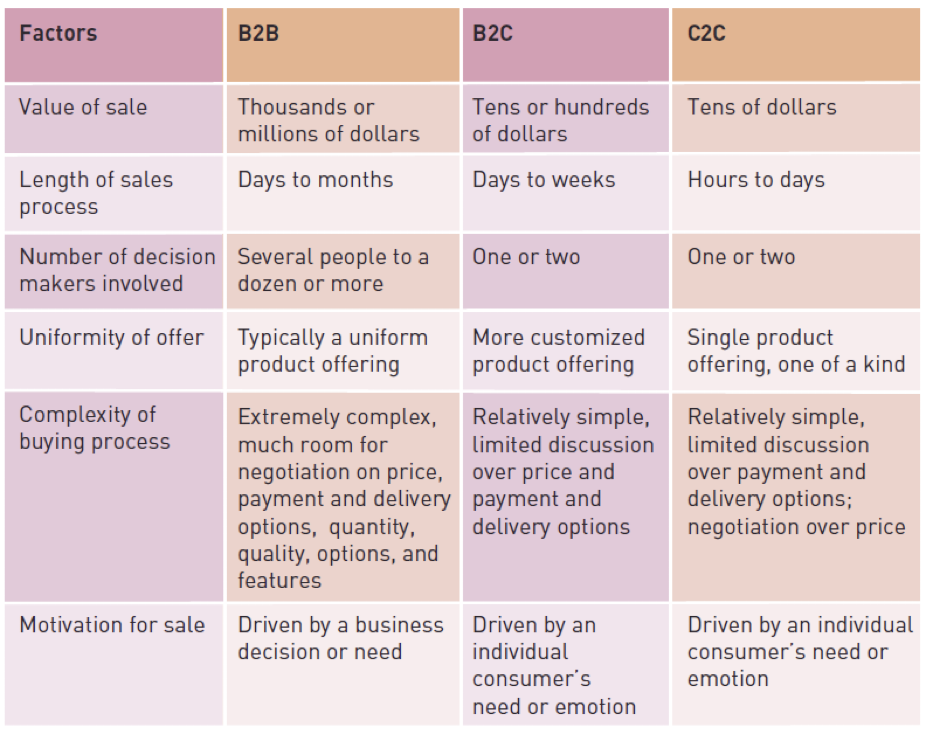
E-Government: use of information and communications technology to:
Simply the sharing of information
Speed formerly paper-based processes
Improve the relationship between citizen and government
Forms of E-Government:
Government-to-Consumer (G2C)
Government-to-Business (G2C)
Government-to-Government (G2G)
Mobile-commerce (m-commerce) relies on the use of wireless devices
The Internet Corporation for Assigned Names and Numbers (ICANN):
Created a .mobi domain to attract mobile users to the web
M-commerce will succeed only if it provides users with real benefits
B2B, B2C, C2C, and m-commerce are used in: retail and wholesale, manufacturing, marketing and advertising, price comparison, couponing, investment and finance, banking and e-boutiques
Electronic Retailing (e-tailing):
Direct sale from business to consumer through electronic storefronts
Cybermall:
Single web site that offers many products and services at one internet location
Manufacturing, repair, and operations (MRO):
Purchases often approach 40% of a manufacturing company’s total revenue
Manufacturing:
Electronic exchange: electronic forum where manufacturers, suppliers, and competitors buy and sell goods, trade market information, and run back-office operations
Private exchange: owned and operated by a single company
Public exchanges: owned and operated by industry groups
Market segmentation: identification of specific markets to target them with advertising messages
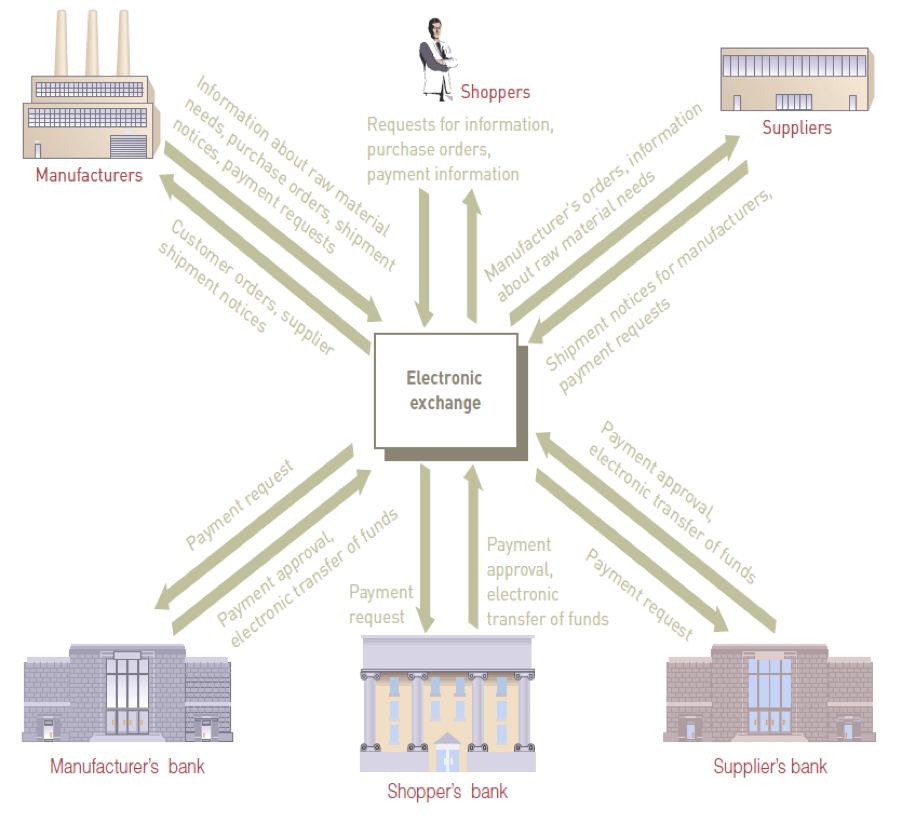
Advertising:
Mobile and impressions are generally bought at cost per thousand (CPM), cost per click (CPC), or cost per action (CPA)
Price comparison: mobile phones services enable shoppers to compare prices and products on the web
Couponing: shoppers can subscribe to mobile coupon aggregators
Investment and Finance:
The Internet: revolutionised the world of investment and finance
The brokerage business: adapted to the internet faster than any other arm of finance
Online banking customers can check balances, transfer money, and pay their bills
Hardware:
Key e-commerce infrastructure factor: web server hardware platform complete with the appropriate software
Key decision facing new e-commerce companies: to host their own web site or let someone else do it
Each e-commerce website must have web server software to perform fundamental services:
Security and identification
Retrieval and sending of web pages
Web site tracking
Website development
Web page development
Difference between web page and web site is that a website is the entire site, whereas a web page is the first page of the web site
The E-Commerce Software should be able to manage the catalogue, configure products to help customers, have shopping cart facilities, e-commerce transaction processing, and web traffic data analysis
M-Commerce Hardware and Software: For the m-commerce to work effectively, the interface between the wireless, handheld device and its user must improve
Encryption can provide secure transmission
Wireless Application Protocol (WAP): standard set of specifications for internet applications that run on handheld, wireless devices
Electronic Payment Systems:
Digital certificate: attachment in a website that verifies the identity of a sender or website
Certificate authority (CA): trusted third party organisation that issues digital certificates
Secure sockets layer (SSL): used to secure sensitive data
Electronic cash: amount of money that is computerised for e-commerce transactions
Smart card: card sized device with a microchip for electronic memory and processing capability
P-card: credit card used to streamline the traditional purchase order and invoice payment process
Transaction Processing Systems (TPS):
Can capture detailed data necessary to update records about fundamental business operations
Include order entry, inventory control, payroll account payable
Provide employees with data to help them achieve their goals
Traditional transaction processing methods and objectives
Batch processing system:
Data processing of business transactions as they accumulate over a period of time and are prepared for processing as a single unit or batch
Online transaction processing (OLTP):
Data processing in which each transaction is processed immediately
Transaction Processing System: an information processing system for business transactions involving the collection, modification and retrieval of all transaction data.
TPS captures and processes data that describes fundamental business transactions
Updates databases
Produces a variety of reports
Transaction processing cycle:
The process of data collection, data editing, data correction, data manipulation, data storage, and document production
Data Collection:
Capturing and gathering all data necessary to complete the processing of transactions
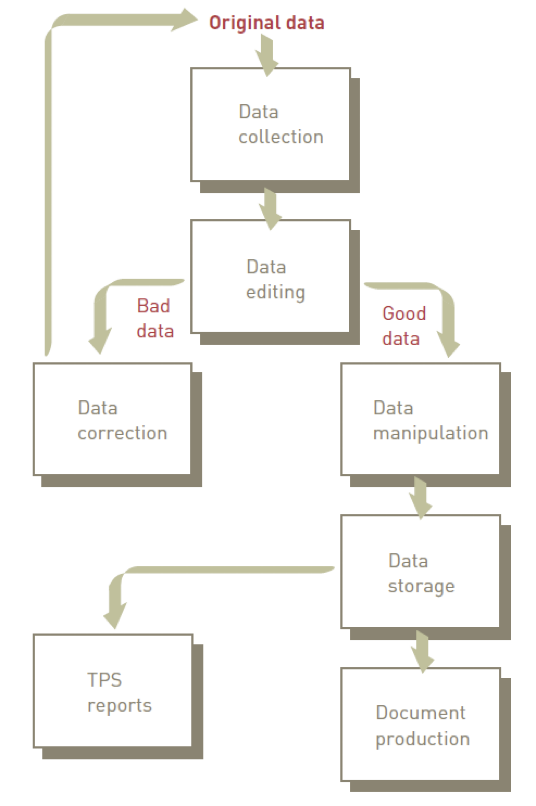
Data collection should be collected at source, recorded accurately, in a timely fashion
Data collection __could__be manual or automated via special input devices
POS Transaction Processing System:
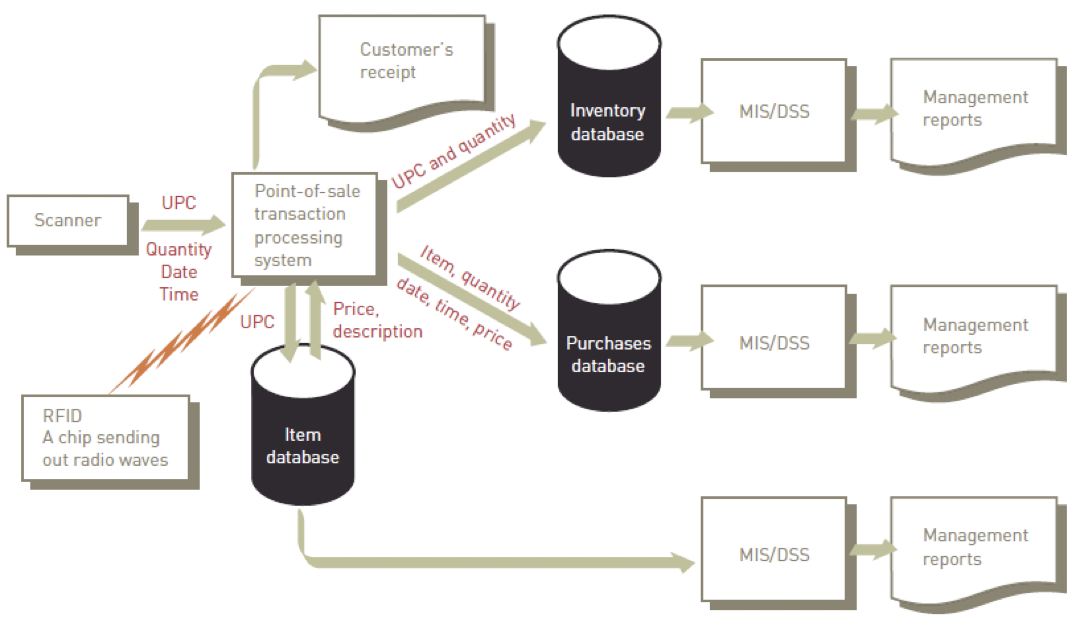
Data Editing: checking data for validity and completeness to detect any problems
Examples: quantity and cost data must be numeric, names must be alphabetic
Data Correction: reentering data that was not typed or scanned properly
Error messages must specify the problem so proper corrections can be made
Data Manipulation: performing calculations and other data transformations related to business transactions
Can include: classifying data, sorting data into categories, performing calculations, summarising results, storing data in the organisation’s database for further processing
Data Storage: updating one or more databases with new transactions
After being updated, this data can be further processed and manipulated by other systems
Document Production and Reports:
Generating output records, documents, and reports
Hard-copy paper reports
Displays on computer screens
Results from one TPS can be inputs to another system
A TPS usually includes the following types of systems:
Order processing systems
Accounting systems
Purchasing systems
Enterprise Resource Planning: software used by a company to manage key parts of operations, including accounting and resource management
ERP systems:
Central to the organisation
Ensure information can be shared across all business functions
Employ a database of key operational and planning data that can be shared by all
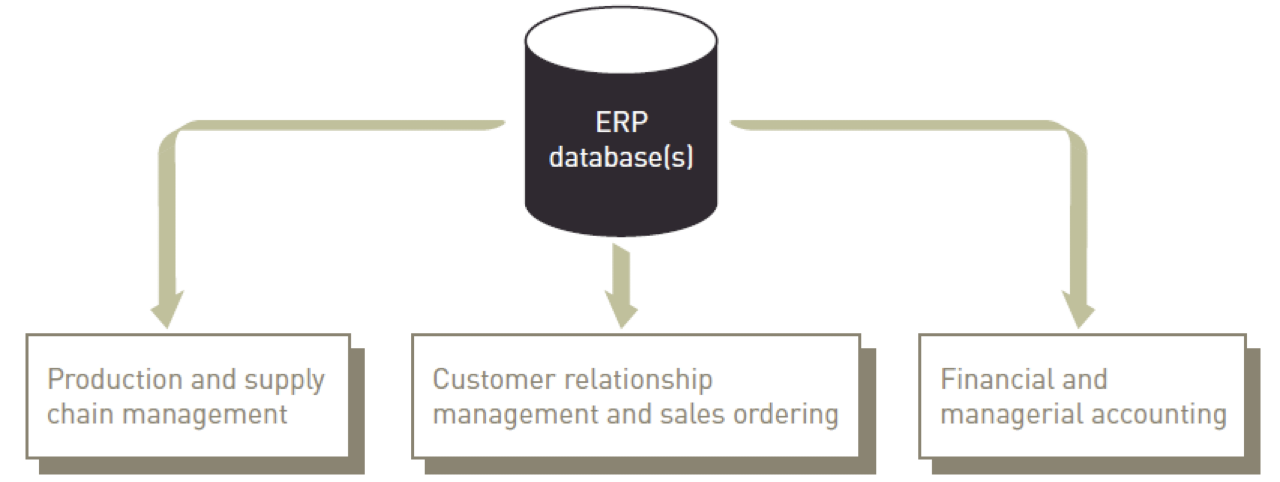
ERP systems evolved from materials requirement planning system (MRP). Large organisations are the first to take on the challenge of implementing ERP
Advantages of ERP:
Improved access to data for operational decision making
Elimination of costly, inflexible legacy systems
Improvement of work processes
Upgrade of technology infrastructure
Disadvantages of ERP:
Expense and time in implementation
Difficulty implementing change
Difficulty integrating with other systems
Difficulty in loading data into new ERP system
Risks in using one vendor
Risk of implementation failure
ERP for small and medium-size enterprises (SMEs):
Many SMEs elect to implement open-source ERP systems
Anyone can see and modify the source code to customise it to meet their needs with open-source software
Supply Chain Management is the management of the flow of goods and services and includes all processes that transform raw materials into final products
It includes:
Planning, executing, and controlling all activities involved in raw material sourcing and procurement
Converting raw materials to finished products and warehousing and delivering finished product to customers
Process for developing a production plan:
Sales forecasting
Sales and operations plan (S&OP)
Demand management
Detailed scheduling
Materials requirement planning (MRP)
Purchasing
Production
Financial and Managerial Accounting
General ledger: main accounting record of a business
ERP system:
Captures transitions entered by workers in all function areas of a business
Creates associated general ledger record to track the financial impact of the transaction
Hosted software model for enterprise software: means the small business firm does not need to employ a full-time IT person to maintain key business applications
Advantages & Disadvantages:

Challenges faced by multinational corporations when planning, building, and operating their TPSs:
Dealing with different languages and cultures
Disparities in IS infrastructure
Varying laws and customs rules
Multiple currencies
Ch 5 - Electronic and Mobile Commerce and Enterprise Systems
Electronic Commerce: conducting business activities electronically over computer networks
Types of E-Commerce:
Business-to-business (B2B): all participants are organisations. It is a useful tool for connecting business partners in a virtual supply chain to cut resupply times and reduce costs
Business-to-Consumer (B2C): where customers deal directly with an organisation and avoid intermediaries
Consumer-to-Consumer (C2C): Involves consumers selling directly to other consumers. Example: craigslist, eBid, bidzcom
Disintermediation: the elimination of intermediate organisations between the producer and the consumer

E-Government: use of information and communications technology to:
Simply the sharing of information
Speed formerly paper-based processes
Improve the relationship between citizen and government
Forms of E-Government:
Government-to-Consumer (G2C)
Government-to-Business (G2C)
Government-to-Government (G2G)
Mobile-commerce (m-commerce) relies on the use of wireless devices
The Internet Corporation for Assigned Names and Numbers (ICANN):
Created a .mobi domain to attract mobile users to the web
M-commerce will succeed only if it provides users with real benefits
B2B, B2C, C2C, and m-commerce are used in: retail and wholesale, manufacturing, marketing and advertising, price comparison, couponing, investment and finance, banking and e-boutiques
Electronic Retailing (e-tailing):
Direct sale from business to consumer through electronic storefronts
Cybermall:
Single web site that offers many products and services at one internet location
Manufacturing, repair, and operations (MRO):
Purchases often approach 40% of a manufacturing company’s total revenue
Manufacturing:
Electronic exchange: electronic forum where manufacturers, suppliers, and competitors buy and sell goods, trade market information, and run back-office operations
Private exchange: owned and operated by a single company
Public exchanges: owned and operated by industry groups
Market segmentation: identification of specific markets to target them with advertising messages

Advertising:
Mobile and impressions are generally bought at cost per thousand (CPM), cost per click (CPC), or cost per action (CPA)
Price comparison: mobile phones services enable shoppers to compare prices and products on the web
Couponing: shoppers can subscribe to mobile coupon aggregators
Investment and Finance:
The Internet: revolutionised the world of investment and finance
The brokerage business: adapted to the internet faster than any other arm of finance
Online banking customers can check balances, transfer money, and pay their bills
Hardware:
Key e-commerce infrastructure factor: web server hardware platform complete with the appropriate software
Key decision facing new e-commerce companies: to host their own web site or let someone else do it
Each e-commerce website must have web server software to perform fundamental services:
Security and identification
Retrieval and sending of web pages
Web site tracking
Website development
Web page development
Difference between web page and web site is that a website is the entire site, whereas a web page is the first page of the web site
The E-Commerce Software should be able to manage the catalogue, configure products to help customers, have shopping cart facilities, e-commerce transaction processing, and web traffic data analysis
M-Commerce Hardware and Software: For the m-commerce to work effectively, the interface between the wireless, handheld device and its user must improve
Encryption can provide secure transmission
Wireless Application Protocol (WAP): standard set of specifications for internet applications that run on handheld, wireless devices
Electronic Payment Systems:
Digital certificate: attachment in a website that verifies the identity of a sender or website
Certificate authority (CA): trusted third party organisation that issues digital certificates
Secure sockets layer (SSL): used to secure sensitive data
Electronic cash: amount of money that is computerised for e-commerce transactions
Smart card: card sized device with a microchip for electronic memory and processing capability
P-card: credit card used to streamline the traditional purchase order and invoice payment process
Transaction Processing Systems (TPS):
Can capture detailed data necessary to update records about fundamental business operations
Include order entry, inventory control, payroll account payable
Provide employees with data to help them achieve their goals
Traditional transaction processing methods and objectives
Batch processing system:
Data processing of business transactions as they accumulate over a period of time and are prepared for processing as a single unit or batch
Online transaction processing (OLTP):
Data processing in which each transaction is processed immediately
Transaction Processing System: an information processing system for business transactions involving the collection, modification and retrieval of all transaction data.
TPS captures and processes data that describes fundamental business transactions
Updates databases
Produces a variety of reports
Transaction processing cycle:
The process of data collection, data editing, data correction, data manipulation, data storage, and document production
Data Collection:
Capturing and gathering all data necessary to complete the processing of transactions

Data collection should be collected at source, recorded accurately, in a timely fashion
Data collection __could__be manual or automated via special input devices
POS Transaction Processing System:

Data Editing: checking data for validity and completeness to detect any problems
Examples: quantity and cost data must be numeric, names must be alphabetic
Data Correction: reentering data that was not typed or scanned properly
Error messages must specify the problem so proper corrections can be made
Data Manipulation: performing calculations and other data transformations related to business transactions
Can include: classifying data, sorting data into categories, performing calculations, summarising results, storing data in the organisation’s database for further processing
Data Storage: updating one or more databases with new transactions
After being updated, this data can be further processed and manipulated by other systems
Document Production and Reports:
Generating output records, documents, and reports
Hard-copy paper reports
Displays on computer screens
Results from one TPS can be inputs to another system
A TPS usually includes the following types of systems:
Order processing systems
Accounting systems
Purchasing systems
Enterprise Resource Planning: software used by a company to manage key parts of operations, including accounting and resource management
ERP systems:
Central to the organisation
Ensure information can be shared across all business functions
Employ a database of key operational and planning data that can be shared by all

ERP systems evolved from materials requirement planning system (MRP). Large organisations are the first to take on the challenge of implementing ERP
Advantages of ERP:
Improved access to data for operational decision making
Elimination of costly, inflexible legacy systems
Improvement of work processes
Upgrade of technology infrastructure
Disadvantages of ERP:
Expense and time in implementation
Difficulty implementing change
Difficulty integrating with other systems
Difficulty in loading data into new ERP system
Risks in using one vendor
Risk of implementation failure
ERP for small and medium-size enterprises (SMEs):
Many SMEs elect to implement open-source ERP systems
Anyone can see and modify the source code to customise it to meet their needs with open-source software
Supply Chain Management is the management of the flow of goods and services and includes all processes that transform raw materials into final products
It includes:
Planning, executing, and controlling all activities involved in raw material sourcing and procurement
Converting raw materials to finished products and warehousing and delivering finished product to customers
Process for developing a production plan:
Sales forecasting
Sales and operations plan (S&OP)
Demand management
Detailed scheduling
Materials requirement planning (MRP)
Purchasing
Production
Financial and Managerial Accounting
General ledger: main accounting record of a business
ERP system:
Captures transitions entered by workers in all function areas of a business
Creates associated general ledger record to track the financial impact of the transaction
Hosted software model for enterprise software: means the small business firm does not need to employ a full-time IT person to maintain key business applications
Advantages & Disadvantages:

Challenges faced by multinational corporations when planning, building, and operating their TPSs:
Dealing with different languages and cultures
Disparities in IS infrastructure
Varying laws and customs rules
Multiple currencies
 Knowt
Knowt
